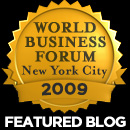Aug10
How to Find Opportunities in Fragmentation
Point: If you’re looking for a new business opportunity, look for individually-fragmented but collectively large areas of economic activity, such as where individuals or small business own a large segment of the market
Story: A business model that connects small businesses and individuals to markets and automates tedious tasks was common to three of 11 new start-ups seeking funding at Techstars Demo Day August 5, 2010. Here are their stories, followed by six action steps you can take to tap such markets.
Rentmonitor.com helps small-scale landlords. These landlords ![]() collectively own 30 million rental units in the US. Rentmonitor offers an online service that automates many elements of the five key tasks that every landlord faces: 1) advertising available properties; 2) screening renter applications; 3) managing maintenance requests; 4) tracking rental payments; and 5) record-keeping for taxes. In exchange for a monthly fee of only $5-$50 (depending on the number of units), Rentmonitor gives the landlord a suite of online tools to manage their properties. Renters also have access to Rentmonitor to submit a maintenance request or make an online rent payments.
collectively own 30 million rental units in the US. Rentmonitor offers an online service that automates many elements of the five key tasks that every landlord faces: 1) advertising available properties; 2) screening renter applications; 3) managing maintenance requests; 4) tracking rental payments; and 5) record-keeping for taxes. In exchange for a monthly fee of only $5-$50 (depending on the number of units), Rentmonitor gives the landlord a suite of online tools to manage their properties. Renters also have access to Rentmonitor to submit a maintenance request or make an online rent payments.
VacationRentalPartner.com addresses the needs of vacation homeowners who rent out their properties when they are not using them. Currently, many vacation homeowners pay a 30% to 50% cut out of their rental revenues to property managers. VacationRentalPartner.com replaces that high-cost property manager with low-cost online services to handle advertising, booking, and housekeeping and maintenance contractors. Although VacationRentalPartner seems similar to Rentmonitor, the two start-ups differ significantly because the needs of ultra-short-term vacation property owners differ significantly from the needs of long-term lease-based landlords. For example, VactionRentalPartner has tools to help fill-in unrented days, such as by promoting off-season rentals to prior guests or with special deals to already-booked renters if they extend their stay to covered the unrented days. VacationRentalPartner also emphasizes the benefits of fast automated responses to booking inquiries. Would-be vacationers expect instant replies from property holders — a less-than-30 second response time to an availability inquiry increases bookings by 200%.
AdStruc.com targets outdoor advertisers with an auction and listing-based marketplace for the buyers and sellers of billboard space. Adstruc address the fragmentation of national,  regional, and local billboard site owners that make it hard for advertisers, especially national advertisers, to find and buy the best billboard sites for a large campaign. AdStruc aggregates billboard sites and provides searchable data on available inventory. AdStruc gives buyers virtual visits to billboard sites through Google Streetview. AdStruc also partnered with Circle Graphics on the printing and shipping of the extremely large format. AdStruc supports the sellers, too, in managing their inventory. “This-space-available” and obsolete signs represent $750 million a year in lost revenue. With AdStruc, sellers can upload their available spaces, automate sales to approve buyers, and auction off space. AdStruc makes money on a share of the transaction fees as well as monthly service fees for managing billboard inventories.
regional, and local billboard site owners that make it hard for advertisers, especially national advertisers, to find and buy the best billboard sites for a large campaign. AdStruc aggregates billboard sites and provides searchable data on available inventory. AdStruc gives buyers virtual visits to billboard sites through Google Streetview. AdStruc also partnered with Circle Graphics on the printing and shipping of the extremely large format. AdStruc supports the sellers, too, in managing their inventory. “This-space-available” and obsolete signs represent $750 million a year in lost revenue. With AdStruc, sellers can upload their available spaces, automate sales to approve buyers, and auction off space. AdStruc makes money on a share of the transaction fees as well as monthly service fees for managing billboard inventories.
Action
- Look for individually-fragmented but collectively large areas of economic activity, such as where individuals or small business own a large segment of the market
- Find the “pain points” in the lifecycle activities of these market participants (e.g., advertising vacant space, vetting renters, researching an opportunity, handling tax records)
- Automate these processes and offer an online, software-as-a-service tool suite
- Monetize the service with a low monthly fee, nominal share of transaction price, or through ad sales
- Connect these small businesses or individuals to large markets (or create them) with automated advertising, inquiry support, booking, vetting, etc.
- Help people on the other side of the transaction, too, such as with online booking, online payment, and online management of requests.











